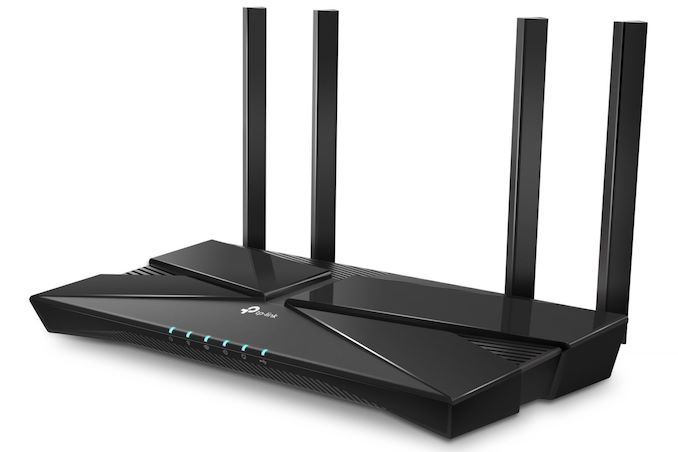AT 101: Wi-Fi 6 And Why You Want It
by Brett Howse on February 12, 2020 8:00 AM EST
Over the last generation of computing, there has been an explosion of devices that no longer have or need the capability of connecting to a hard-wired Ethernet connection, and that trend shows no intention of slowing down. When Personal Computers first started to utilize wireless Network Interface Cards (NICs) they would almost always be the sole device on the network. Fast forward to today, and practically every home has multiple devices, if not dozens, where the devices communicate using radio waves, either over a cellular connection, or over a home wireless network featuring Wi-Fi.
In the PC space, which is the focus of this article, cellular connectivity certainly exists, but almost exclusively in niche roles. While there are advantages to offering directly cellular connection on the PC, the extra recurring cost, especially in North America, means that most laptop owners will use Wi-Fi for network communication.
The term Wi-Fi is something that is omnipresent today, but if based on the Wi-Fi Alliance and adoption of IEEE 802.11 standards for local area networking over wireless. Although the Wi-Fi Alliance has recently renamed their standards, Wi-Fi has in the past been named directly based on the 802.11 standards as follows:
| Wi-Fi Names and Performance | ||||||
| Naming | Peak Performance | |||||
| Branding | IEEE Standard |
1x1 Configuration |
2x2 Configuration |
3x3 Configuration |
||
| Wi-Fi 4 Channel Width 20/40 MHz |
802.11n | 150 Mbps | 300 Mbps | 450 Mbps | ||
| Wi-Fi 5 Channel Width 20/40/80 MHz Optional 160 MHz |
802.11ac | 433 Mbps 867 Mbps |
867 Mbps 1.69 Gbps |
1.27 Gbps 2.54 Gbps |
||
| Wi-Fi 6 Channel Width 20/40/80/160 MHz |
802.11ax | 1201 Mbps | 2.4Gbps | 3.6 Gbps | ||
In an effort to simplify branding, the latest three standards of 802.11n, 802.11ac, and 802.11ax have been rebranded to Wi-Fi 4, Wi-Fi 5, and Wi-Fi 6, respectively. In the long term, the new branding should be much easier for most people to grasp, since larger means newer, although we’ve already got some confusion with Wi-Fi 6E – the 6GHz band addition for Wi-Fi 6 – so we shall see how that goes.
 One of the many Wi-Fi 6 routers announced at CES 2019 - TPLink AX1800
One of the many Wi-Fi 6 routers announced at CES 2019 - TPLink AX1800
Today, most homes should have at least Wi-Fi 4, or what used to be 802.11n. After all, this standard came along in 2009. Many will even have Wi-Fi 5, or 802.11ac, which offers some speed upgrades and a few optional extra features to help with scaling. Wi-Fi 6, or 802.11ax, is a very new standard, and until the end of 2019 there were not even that many devices which could connect over it. So, what is the point of this new standard, and do you really need to upgrade your home network?
This article intends to help answer those questions, as well as show how we at AnandTech are transitioning to Wi-Fi 6 for future reviews.











149 Comments
View All Comments
Nokiya Cheruhone - Wednesday, February 12, 2020 - link
Can't these things not look like turds?WiFi hardware is supposed to blend in the environment. Why does nobody produce a successor to the AirPort Extreme line that has secure firmware and high performance. Miss those days where you could simply buy an AirPort and it would be the most secure and least ugly solution.
ABR - Wednesday, February 12, 2020 - link
I was running an AEBS from 2009 until a few weeks ago. Last month I got a firmware update for it from Apple.Dug - Wednesday, February 12, 2020 - link
I agree. Netgear Orbi isn't bad though. Just too expensive at $650-700 for two units.Nokiya Cheruhone - Wednesday, February 12, 2020 - link
I have a thought that every vendor nowadays kinda treats firmware updates and security over the lifetime of the product like an afterthought, it's not even easy to compare these vendors because most consumers wouldn't care too much (or even know that there is something like embedded firmware in the first place).Nokiya Cheruhone - Wednesday, February 12, 2020 - link
How was your experience with Netgear devices?Makaveli - Wednesday, February 12, 2020 - link
I will only use Netgear router if I can load Asus merlin on it lol.They are slow at patching exploits and the stock firmware isn't great.
Makaveli - Wednesday, February 12, 2020 - link
And this is why I like Asus hardware that support Merlin firmware.He often release updates for exploits before even Asus can for the stock firmware.
I've been using Merlin firmware for 4+ years now on various routers and his timely updates is what has kept me there.
Makaveli - Wednesday, February 12, 2020 - link
Agreed with you here boss I hate the spider looking routers.name99 - Thursday, February 13, 2020 - link
The closest to the Apple experience these days appears to be Amplifi, the home version of Ubiqiti. Same aesthetics, ease of use, mostly bullet-proof. (And same lack of interest in weird tweaks and claims of things that are supposed to improve games or whatever, but mostly don’t work.)They released an ax box maybe six weeks ago. I don’t have direct experience with it, but their ac box has been mostly trouble-free for me.
vFunct - Wednesday, February 12, 2020 - link
No latency measurements?